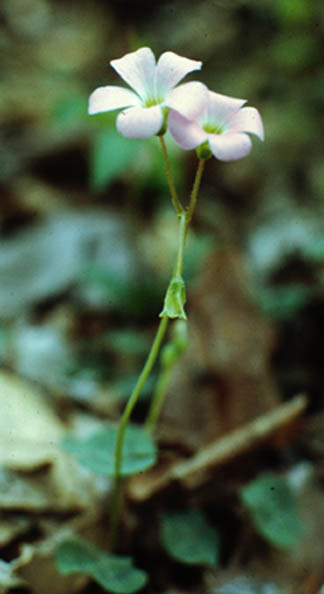
Oxalis violacea.700.jpg35 mm slide scanned with Polaroid Printscan 35 at 2700dpi; set image size to 700 dpi and converted to jpg quality 5 with Adobe Photoshop v4.0 Oxalis violacea Oxalidaceae 0.00000005041972 Kodachrome Photograph courtesy of Univ. of Georgia Herbarium. Copyright Dept. of Botany, Univ. of Georgia, Athens. All rights reserved.
Location and Distribution: Violet wood sorrel is found in 40 of the 50 states, including all states in the southeastern region of the U.S.A. and all the states in the Midwestern U.S.A. The plant is not natively found in any of the western states except Oregon. The plant is native to most natural communities such as upland forests, praries, savannas and successional fields .
Oxalis violaceae L. Distribution
AREA
STATUS
REFERENCES
| North America | Yes | Database |
| Southeastern
U.S.A
AL AR FL GA KY MD NC SC TN VA WV |
Yes | Same as above |
| Southern Appalachian
States AL GA KY MD NC SC TN VA WV |
Yes | Same as above |
| Coastal Plains |
Yes,
Widespread |
Duncan & Kartesz,
1981 |
| Piedmont |
Yes,
Widespread |
Duncan & Kartesz,
1981 |
| Cumberland
Plateau |
No |
Duncan & Kartesz,
1981 |
| Blue Ridge
Mountains |
Yes,
Widespread |
Duncan & Kartesz,
1981 |
| Georgia |
Yes,
Widespread |
Duncan & Kartesz,
1981 |
| Ridge and Valley |
Yes,
Widespread |
Duncan & Kartesz,
1981 |
General Information: Oxalis violacea has a perennial lifecycle, which includes flowering months of April to May. It is an autotrophic plant with C3 carbon dioxide fixation. It reproduces sexually. It may flower again in the late fall. The plant is edible and is a high source of Vitamin C ( SEE Food). O. violaceae is a good indicator of former savannas and open woodlands because these habitats lack canopy conditions. With densely-wooded areas, the plant is less common due to the lack of available sunlight, as wood sorrel is a low-growing herb .
References and Related Web Sites
Used:
Duncan, W.H. & Kartesz,
J.T. 1981. Vascular Flora of Georgia: An Annotated
Checklist. University of Georgia Press, Athens.
Ownbey, G.B. & Morley, T.
1991. Vascular Plants of Minnesota: A Checklist and Atlas.
University of Minnesota, Minneapolis / Oxford.
Weishaupt, C. G. 1968. Vascular
Plants of Ohio: A Manual for Use in Field and Laboratory. W.M.
C. Brown Book Company; Dubuque, Iowa.
Yatskievych, G. & Turner, J. 1990.
Catalogue of the Flora of Missouri. Missouri Botanical Garden.
http://plants.usda.gov
(Follow the links to Oxalis spp.)
http://www.fs.fed.us/ne/deleware/ilpin/2056.co
(Go to original site and follow the links)
http://www.npwrc.usgs.gov/resource/literatr/wildflwr/species/oxalviol.htm
http://www.central.edu/biology/botany/wild/plantsV.html
http://www.iupui.edu/~mreiter/bcfl1985.htm
http://www.botany.com/oxalis.html